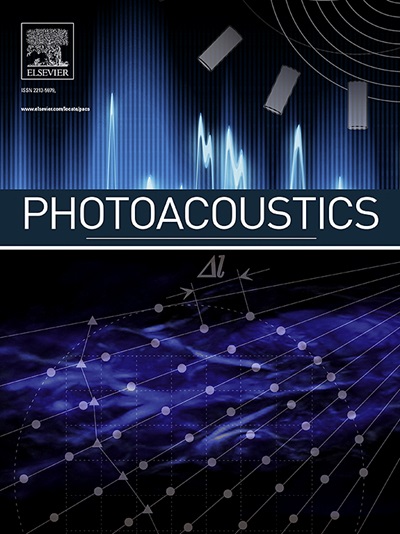多模式PA/US成像和放射组学用于预测her2零、低和阳性乳腺癌:一种靶向治疗选择的新方法
IF 6.8
1区 医学
Q1 ENGINEERING, BIOMEDICAL
引用次数: 0
摘要
目的评价基于光声/超声(PA/US)成像的放射组学在区分her2 - 0、her2 -低和her2阳性乳腺癌(BC)中的疗效,旨在加强靶向治疗的选择。方法对2022年1月至2025年1月在深圳市人民医院行多模式PA/US成像的346例病理确诊的BC患者进行分析。病理检测HER2状态,并将其分为3个水平。放射科医生评估常规的US特征,并在pa图像上手动分割肿瘤以进行放射组学特征提取。使用最小绝对收缩和选择算子分析,我们开发了放射组学模型,用于区分her2 - 0与her2 -低/阳性癌症(任务1),her2 -低与阳性癌症(任务2),以及her2 - 0与低癌症(任务3)。患者被随机分为训练集和测试集。使用多变量逻辑回归将放射组学、临床病理和US特征整合到图中。结果在测试集中,任务1的AUC为0.846,灵敏度为79.3% %,特异性为72.7 %;任务2的AUC为0.801,灵敏度为64.0 %,特异性为82.8 %;任务3的AUC为0.767,灵敏度为80.7 %,特异性为72.7 %。在任务1、2和3中,包括PA成像放射组学特征和临床病理特征的图的auc分别为0.848、0.881和0.780。结论pa放射组学特征可以有效区分HER2- 0和HER2低/阳性,HER2-低和HER2阳性BC,为指导靶向治疗决策提供潜在的实用价值。本研究证明了基于PA成像的放射组学在准确分类BC中HER2表达状态方面的潜力,增强了靶向治疗的选择过程。通过整合多模态成像和病理数据,所开发的放射组学模型显示出强大的性能,有望为传统方法有限的临床应用提供非侵入性诊断补充。本文章由计算机程序翻译,如有差异,请以英文原文为准。
Multimodal PA/US imaging and radiomics for the prediction of HER2-zero, -low, and -positive breast cancers: A novel approach for targeted therapy selection
Purpose
This study evaluates the efficacy of photoacoustic/ultrasound (PA/US) imaging-based radiomics for distinguishing HER2-zero, HER2-low, and HER2-positive breast cancer (BC), aiming to enhance targeted therapy selection.
Methods
We analyzed 346 pathologically confirmed BC patients who underwent multimodal PA/US imaging at Shenzhen People’s Hospital from January 2022 to January 2025. HER2 status was determined pathologically and classified into three levels. Radiologists assessed conventional US features and manually segmented tumors on PA-images for radiomics feature extraction. Using the Least Absolute Shrinkage and Selection Operator analysis, we developed radiomics models for differentiating between HER2-zero versus HER2-low/positive cancers (Task 1), and HER2-low versus positive cancers (Task 2), and HER2-zero versus low cancers (Task 3). Patients were randomly divided into training sets and testing sets. Multivariate logistic regression was used to integrate radiomics, clinical-pathological, and US features into nomograms.
Results
In testing set, radiomics features demonstrated an AUC of 0.846 with sensitivity of 79.3 % and specificity of 72.7 % for Task 1, and an AUC of 0.801 with sensitivity of 64.0 % and specificity of 82.8 % for Task 2, and an AUC of 0.767 with sensitivity of 80.7 % and specificity of 72.7 % for Task 3. For Task 1, 2 and 3, nomograms including PA imaging radiomics features combined with clinical-pathological features achieved AUCs of 0.848, 0.881 and 0.780, respectively.
Conclusion
PA radiomics features effectively differentiate between HER2-zero and HER2 low/positive, and between HER2-low and HER2-positive BC, offering potential utility in guiding targeted therapy decisions.
Summary
This study demonstrates the potential of PA imaging-based radiomics for accurately classifying HER2 expression statuses in BC, enhancing the selection process for targeted therapies. By integrating multi-modal imaging and pathology data, the developed radiomics models show robust performance, promising a non-invasive diagnostic supplementary for clinical application where traditional methods are limited.
求助全文
通过发布文献求助,成功后即可免费获取论文全文。
去求助
来源期刊

Photoacoustics
Physics and Astronomy-Atomic and Molecular Physics, and Optics
CiteScore
11.40
自引率
16.50%
发文量
96
审稿时长
53 days
期刊介绍:
The open access Photoacoustics journal (PACS) aims to publish original research and review contributions in the field of photoacoustics-optoacoustics-thermoacoustics. This field utilizes acoustical and ultrasonic phenomena excited by electromagnetic radiation for the detection, visualization, and characterization of various materials and biological tissues, including living organisms.
Recent advancements in laser technologies, ultrasound detection approaches, inverse theory, and fast reconstruction algorithms have greatly supported the rapid progress in this field. The unique contrast provided by molecular absorption in photoacoustic-optoacoustic-thermoacoustic methods has allowed for addressing unmet biological and medical needs such as pre-clinical research, clinical imaging of vasculature, tissue and disease physiology, drug efficacy, surgery guidance, and therapy monitoring.
Applications of this field encompass a wide range of medical imaging and sensing applications, including cancer, vascular diseases, brain neurophysiology, ophthalmology, and diabetes. Moreover, photoacoustics-optoacoustics-thermoacoustics is a multidisciplinary field, with contributions from chemistry and nanotechnology, where novel materials such as biodegradable nanoparticles, organic dyes, targeted agents, theranostic probes, and genetically expressed markers are being actively developed.
These advanced materials have significantly improved the signal-to-noise ratio and tissue contrast in photoacoustic methods.
 求助内容:
求助内容: 应助结果提醒方式:
应助结果提醒方式:


